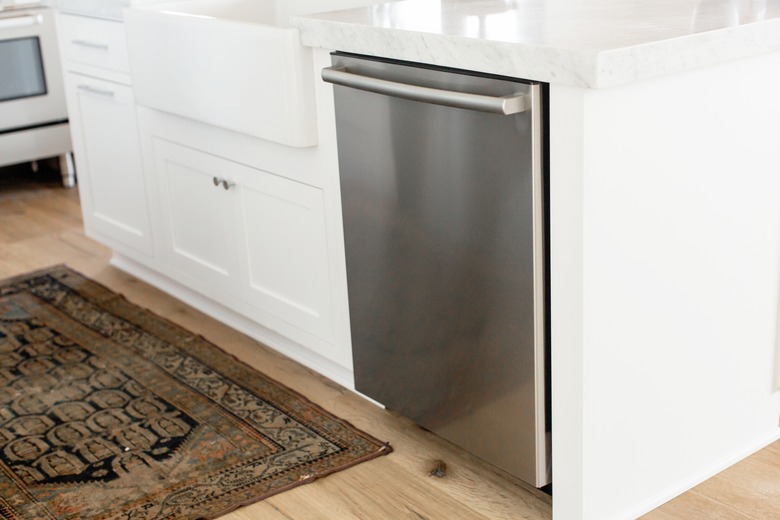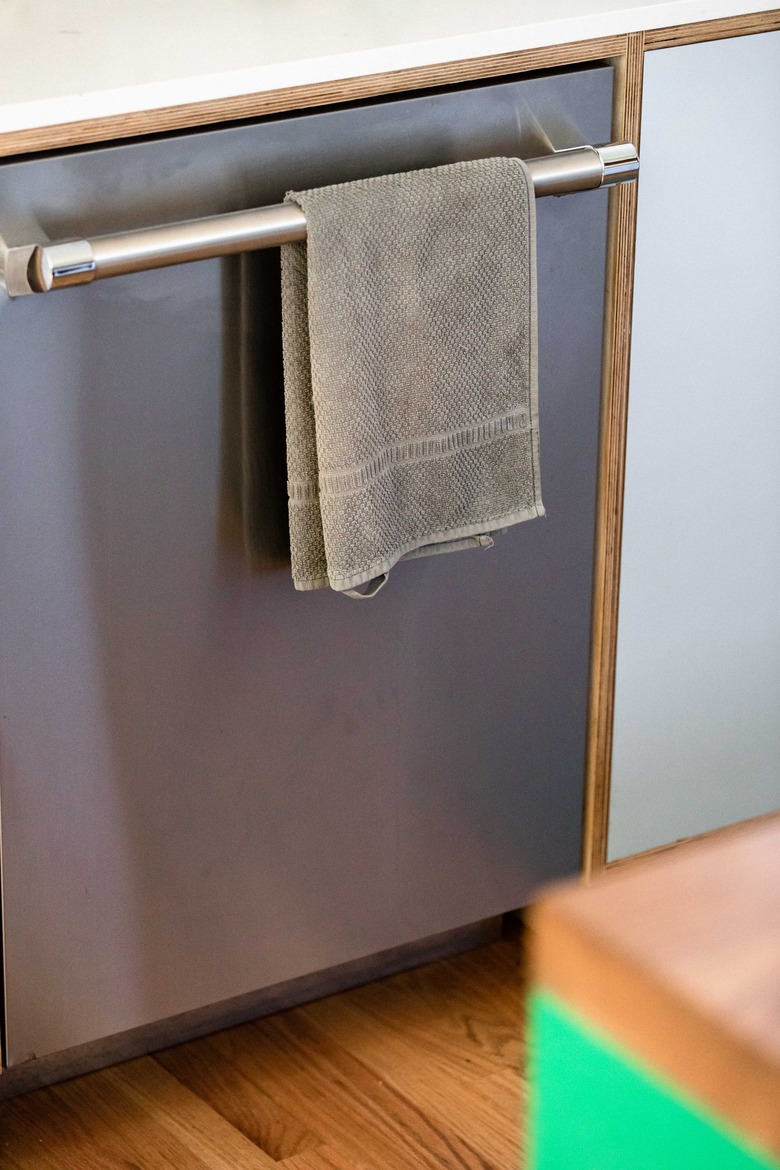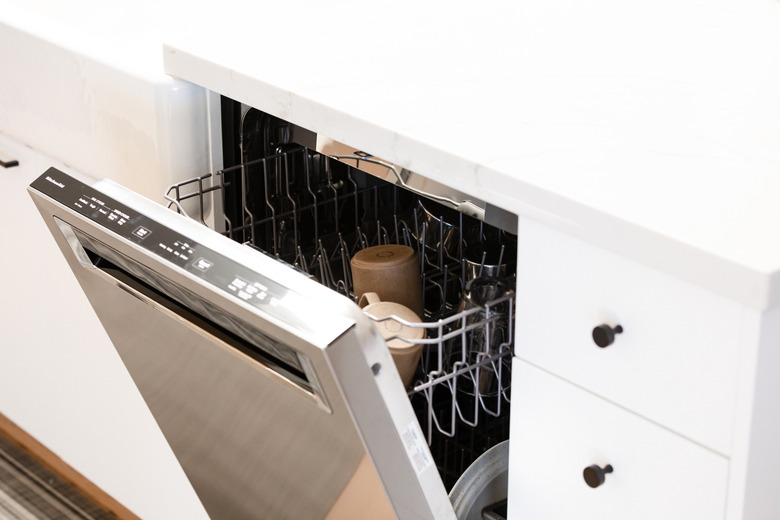How To Install A Dishwasher Drain
If your home improvement plans include a new dishwasher, you'll need an alcove as close as possible to the kitchen sink so you can draw hot water from the kitchen faucet supply and connect the dishwasher drain to the sink drain. The alcove is usually right next to the sink cabinet, but it can be separated by intervening cabinets up to a maximum of 10 to 12 feet depending on the dishwasher manufacturer's specifications.
The dishwasher drain hose connects to the sink drain before the P-trap. If the sink has a garbage disposal, you should find an inlet port on it for the dishwasher drain hose, but if there's no garbage disposal, you have to connect the drain hose to the drain tailpiece, which involves installing a tee. The drain hose must make a high loop or connect to a fitting called an air gap before you make the connection, and the method you should use depends on the code requirements in your area.
High Loop or Air Gap?
High Loop or Air Gap?
When you connect a dishwasher drain to the sink drain, the potential exists for the dishwasher pump to siphon wastewater from the sink and contaminate the dishwasher. To prevent this, the Uniform Plumbing Code (UPC) requires a dishwasher air gap — a small, dome-shaped fitting that mounts to the deck of the kitchen sink or to the countertop. You connect the dishwasher drain hose to the inlet port of the air gap and then you add a short drain hose to the outlet port of the air gap and connect the other end to the sink drain. The air gap includes an air vent that equalizes pressure in the drain line to prevent backflow.
The International Plumbing Code (IPC) recommends air gaps but doesn't require them because it also allows the use of a high loop, which means the drain hose makes a loop, or arc, underneath the sink that rises to the sink rim or the underside of the cabinet. The rationale for the high loop is that the sink can't overflow past its rim, so there should always be enough air in the loop to prevent siphoning. Whether or not you have to install an unsightly air gap or you can employ a high loop depends to a great degree on whether your local plumbing code is based on the UPC or the IPC.
Most western coastal states as well as the northern ones west of Michigan and a few others are UPC states. It's important to check with a plumber or inspector, though, because some state codes aren't specific and leave the decision to local authorities. It's also important to check the installation instructions for the dishwasher. For example, GE dishwasher instructions, referenced by the InterNACHI Inspection Community, specify that the connection on the sink drain tee must be at least 18 inches above the floor to employ the high-loop method.
What Do You Need?
What Do You Need?
Most manufacturers supply a 6-foot, 6-inch length of corrugated drain hose with a new dishwasher. It has rubber fittings on both ends that fit 5/8-, 3/4- and 1-inch stubs, and you secure the ends with metal pipe clamps, which are also supplied. If the distance from the dishwasher to the drain exceeds 6 feet, you'll need to buy a longer hose. For any installation involving an air gap, you'll need a short hose in addition to the long drain hose. You can buy a dishwasher drain kit that includes everything you need from the dishwasher supplier.
If you're connecting the drain directly to the drain tailpiece, you'll need a tee, and rather than gluing one into your existing tailpiece, it's easier to replace the old tailpiece with a new one that has a built-in tee; this is called a branch tailpiece. A plastic one costs less than $5, while a metal one costs about $15. The best way to connect to a double-sink drain is to replace the tee connecting the sink waste arms to the P-trap with one that has an inlet port for the dishwasher, as pictured at Whitten Plumbing Solutions.
How to Install a Dishwasher Drain
1. Drill Holes for the Drain Hose
Use a drill and a 1 3/8-inch spade bit or hole saw to make a hole in the cabinet wall between the dishwasher alcove and the sink cabinet. Some plumbers recommend making this as high in the cabinet wall as possible, but you should do this only if there's enough room in the alcove to bend the drain hose upward without kinking it. In most cases, it's best to make the hole about 3 or 4 inches above the bottom of the sink cabinet.
If the dishwasher alcove is separated from the sink cabinet by one or two additional cabinets, drill holes in the cabinet walls for the drain hose as close to the back and bottom as possible. It's best to line up the holes to avoid bends in the hose, which take up space.
2. Prepare the Sink Tailpiece or Garbage Disposal Inlet
Install a branch tailpiece by disassembling the P-trap, unscrewing the existing tailpiece compression nut using locking pliers and then removing the tailpiece. Cut the branch tailpiece to the same length as the one you removed using a hacksaw. Install the tailpiece onto the sink drain, tighten the compression nut with pliers and reassemble the P-trap.
If you're connecting the dishwasher drain to a garbage disposal, you may have to remove a plug (a plastic disc) from inside the dishwasher drain inlet port on the disposal. To remove the plug, insert a screwdriver into the port and tap the screwdriver with a hammer to break out the plug. The disc will fall into the disposal's grinding chamber, and you need to fish it out through the sink opening. Turn off the power to the disposal at your home's breaker box and then reach into the disposal and pull out the disc. Then you can turn the power back on.
According to the plumbing code, the drain connection on the garbage disposal must be on the same side of the sink cabinet as the dishwasher.
3. Install an Air Gap if Required
If your sink has a hole for a soap dispenser or side sprayer, you can mount the air gap in that hole. Otherwise, you'll have to drill a 1 3/8-inch hole in the sink or countertop. Slip the washer onto the top part of the air gap fitting, drop the fitting into the hole and screw on the bottom half, which includes the inlet and outlet stubs. Tighten the connection with pliers.
4. Connect the Drain Hose to the Dishwasher
Lay the dishwasher on its side and slip a hose clamp onto the end of the drain outlet followed by the hose connection. Slip the clamp over the hose fitting and tighten the clamp with a screwdriver. Set the dishwasher upright and route the drain hose out from underneath the unit; usually, there is a molded part that accommodates the hose.
5. Feed the Hose Into the Sink Cabinet
Set the rear leveling feet of the dishwasher and walk the dishwasher into the alcove while you feed the other end of the dishwasher drain hose as well as the hot water supply line and power cord into the holes you drilled in the cabinet. This part of the dishwasher installation is easier if you have a helper.
6. Hook Up to the Air Gap or Make a Loop
Secure the drain hose to the air gap inlet with a hose clamp if you are using the air gap method. Extend a second length of hose from the air gap to the drain inlet and secure both ends with hose clamps. If you are using the loop method, secure the drain hose loosely to the underside of the sink cabinet with a hose bracket — the hose should make a tall arch without kinking — and then connect the end of the hose to the drain inlet and secure it with a clamp.
References
- The Journal of Light Construction: Dishwasher Drain Distance
- InterNACHI Inspection Community: List of States Allowing Dishwasher Air Gap
- International Association of Plumbing and Mechanical Officials: 419.2 Drainage Connection
- Allstarce: 2015 IPC Code: Chapters 8-9 Sections 801-918.8 Indirect/Special Waste


